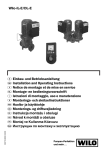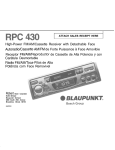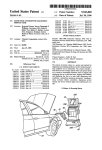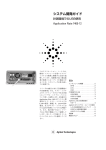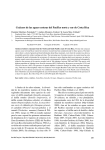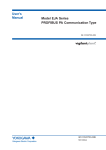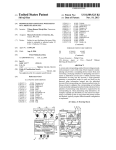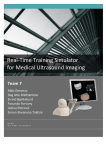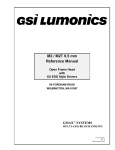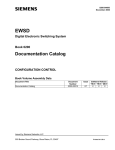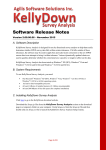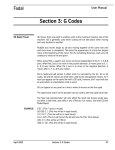Download Vehicular dual mode master/slave interface
Transcript
US008433463B1 (12) United States Patent Lieberman et al. (54) US 8,433,463 B1 (10) Patent N0.: (45) Date of Patent: (56) VEHICULAR DUAL MODE MASTER/SLAVE INTERFACE Apr. 30, 2013 References Cited U.S. PATENT DOCUMENTS (75) Inventors: David Lieberman, Independence, MN (US); Robert Turgeon, Plymouth, MN (US); Byron Tietjen, Baldwinsville, NY 5,758,300 A * 5/1998 5,797,088 A 8/1998 Stamegna 5,878,276 A * 5,991,640 A (US); Greg Gardella, Independence, MN (US) (73) Assignee: Nordic Capital Partners, LLC, 3/1999 5,999,867 A * 12/1999 6,161,066 A * 6,181,992 B1* 12/2000 Wright et al. .. 1/2001 Gurne et a1. Rogers et al. .............. .. 701/33.2 6,298,376 B1* 10/2001 701/36 .. 701/31.4 Rosner et al. ............... .. 709/209 (Continued) Subject to any disclaimer, the term of this patent is extended or adjusted under 35 U.S.C. 154(b) by 21 days. OTHER PUBLICATIONS Bruce et al., Personal Digital Assistant (PDA) based I2C bus analysis, Nov. 2003, IEEE.* (21) Appl. N0.: 13/461,751 (22) Filed: Aebliet al. ................... .. 710/19 11/1999 Lilja et al. Plymouth, MN (US) Notice: Abe ............................ .. 455/424 (Continued) May 1, 2012 Primary Examiner * Thomas Black Assistant Examiner * Sara Lewandroski (74) Attorney, Agent, or Firm * Thompson Patent Law Related US. Application Data (60) Of?ces PC; Craige Thompson Provisional application No. 61/617,277, ?led on Mar. 29, 2012, provisional application No. 61/623,222, (57) ?led on Apr. 12, 2012, provisional application No. 61/621,497, ?led on Apr. 7, 2012, provisional application No. 61/621,630, ?led on Apr. 9, 2012, provisional application No. 61/621,495, ?led on Apr. A vehicular interface may include an electromechanical inter face between a handheld electronic device and subsystems on a vehicular bus or network. In selected embodiments the interface may operate in a “master mode” when a handheld device, such as a tablet computer or smart-phone, is not 7, 2012, provisional application No. 61/603,330, ?led on Feb. 26, 2012, provisional application No. 61/597, ABSTRACT 045, ?led on Feb. 9, 2012. inserted therein. In this mode the interface may serve as a master controller and accesses and controls various sub (51) Int. Cl. systems on a vehicle (such as engine control subsystems, media controllers, navigation systems, sensors and transduc (52) US. Cl. G06F 3/00 (2006.01) ers) as a master controller. In one embodiment, when a tablet 709/217; 709/211; 709/1 device is inserted into the interface, the interface may auto matically switch to “slave mode” in which it acts as an adapter or interface between the tablet device and the vehicular sub systems. In this mode of operation the user’s exclusive inter Field of Classi?cation Search ........... .. 701/2, 33.2, face is through the tablet computer and the tablet computer USPC ................ .. 701/21; 701/2; 701/332; 701/36; 710/303; 710/304; 710/110; 710/106; 710/313; (58) 701/36; 710/303, 304, 110, 106, 313; 709/217, serves as the master controller for the system. 709/211 See application ?le for complete search history. ExTERNAL DTsPLAv DEV1CES(EDD) Eg?w DEvTcE 1 DATA 21 Claims, 12 Drawing Sheets OPTTONAL ENVIRONMENT PROOFIRESISTANT CONTAINER’ coNNANDssTATUs WM,‘ 1, USB BLUETOOTH POWER DATA DEvTcE WM,‘ 2 use ELuETooTR MASTERISLAVE INTERFACE DEVICE -., coNvERTERs ADcs DAcs Wl-FT 1/0 BLUETOOTH To BEAcoN [OPT] DATA CARD READER CONTROLS STATUS DATA EXNLZTKT coNlNANDs STATUS A POWER DEvTcE <:W‘_F| -., 1 USB BLUETOOTH 3 Wl-FT : EXTERNAL DATA CRADLE DEV‘CE W‘ muggom ExTERNALcoNTRnL amsPLAv DEVICE (E60) - TPAD - SMART RHoNE ' FDA - PC/LAPTOP TACHOMETER ,1 2 "iv ‘ V - ETC. NMEAmss sTANDARD USB BLUETOOTH REDUNDANT coMMs % EXTERNAL DATA COMMANDS sTATus DEvTcE Wm N us B BLUETOOTH ONBOARD EXTERNAL ONBOARD DEV1CES(EOD) NMEA 0183 STANDARD INTERFACE PROTOCOL g‘ggTRgégf BUTLT-TN APPLTCATTONS - WT-FT ' CELL MODEM » ' GPS - SATELLITE - INTERNET ‘TNSULATES AGATNST WEATHER, VIBRATION. WATER‘ ETC liWER US 8,433,463 B1 Page 2 US. PATENT DOCUMENTS . 51* 7,113,449 B2 7,299,129 B2 a a 2011/0153150 A1* 2011/0213515 A1 6/2011 9/2011 $5882 511.11%.~~~~~~~~~~~~~~~~~~~~~~~ ~~ 455/6711 2011/0234117 A1* 9/2011 Knapp et a1. ................ .. 315/291 9/2006 F 1.118 .1 2011/0264835 A1* 10/2011 Chenet a1. .................. .. 710/106 11/2007 K212351211 ' 2012/0028680 A1 Drew et a1. ................... .. 701/33 Hayrnart et a1. 2/2012 Breed * 7,398,151 B1* 7/2008 Burrell et a1. ............... .. 701/410 2012/0053759 A1,, 3/2012 L-owreyetal' """"""""" " 70m 7686 396 B2 7,784,707 B2 3/2010 S h f 8/2010 vsitéayaetal 2012/0117290 A1 2012/0166676 A1* 5/2012 S1rpaleta1. 710/303 6/2012 Roper et a1. ................ .. 709/250 2004/0249860 A1 12/2004 Stechschulte et a1. 2005/0239434 A1 10/2005 Marlowe 2006/0l55431 A1>1< 2006/01g4613 A1 7/2006 Berg et a1‘ ““““““““““““ “ 701/2 8/2006 Stienessen et a1‘ 2006/024g162 A1 * 2007/0203646 A1* 11/2006 Kawasaki ,,,,,,,,,,,,,,,,, H 709/217 8/2007 Diaz etal, ,,,,,,,,,,,,,,,,,,, ,, 701/213 2010/0097239 A1 4/2010 campbellet a1, 2011/0118934 A1* 5/2011 2011/0144912 A1 6/2011 Lee et a1. OTHER PUBLICATIONS _ AM186 ED/EDEV Mlcrocontrollers Users Manual, 1996,AMD.* MC68332Techn1cal Summary, 1995,Freescal Semiconductor, Inc.* Palm Z22 Product Details, Oct. 2005, Epini0ns.c0m.* Lenovo X200 Performance, 2008, Len9v0'* AM186 ED/EDLV Microcontrollers User’s Manual, 1996, AMD.* Lowrey et a1. ................ .. 701/33 * cited by examiner US. Patent Apr. 30, 2013 Sheet 1 0f 12 US 8,433,463 B1 US. Patent Apr. 30, 2013 Sheet 2 0f 12 US 8,433,463 B1 US. Patent Apr. 30, 2013 Sheet 4 0f 12 US 8,433,463 B1 .GEw Emw l @ _ 02$ m@928 E58<_>v5x2 5%GE98mNET: MQIZ2OE‘S 3 mm; mwcuomw: 96common_ US. Patent Apr. 30, 2013 Sheet 8 0f 12 US 8,433,463 B1 US. Patent Apr. 30, 2013 Sheet 9 0f 12 US 8,433,463 B1 POWER DOWN STATE A POWER UP STATE MSID MASTER STATE ECD PRESENT ? FIG. 9 MSID SLAVE STATE US. Patent Apr. 30, 2013 Sheet 10 0f 12 US 8,433,463 B1 POWER DOWN STATE POWER APPLIED ? POWER UP STATE MSID MASTER STATE ECD PRESENT ? MSID SLAVE STATE M V - POLL EODS FOR AVAILABILITY - SET UP MSID FOR CONTROL OvER EODS - SET UP MSID GUI TO ACCEPT COMMANDS FROM THE USER - SET UP MSID TO DISPLAY EOD DATAAS SELECTED BY MSID GUI V - POLL EODS FOR AVAILABILITY - SET UP MSID FOR PASS THROUGH OF ECD COMMANDS TO THE EODS - SET UP MSID ROUTE DATA FROM EODS To THE ECD AS COMMANDED BY THE ECD V V FIG. 10 US. Patent Apr. 30, 2013 US 8,433,463 B1 Sheet 11 0f12 A a A M HIGHLY PROBABLE SQIVIEEIIIVHAT PROBABLE POSSIBLE PERIPHERAL EDD REMOTE DISPLAY/S LINK BLUETOOTH WI-FI CABLE OTHER APPLICATION WATERCRAFT AUTOMOBILE BLUETOOTH WI-FI GPS* CABLE OTHER BLUETOOTH WI-FI RADIO/TV CABLE OTHER BLUETOOTH DEPTH WI-FI SOUNDER/ CABLE TRANSDUCER OTHER BLUETOOTH WI-FI RADAR CABLE OTHER EOD BLUETOOTH WI-FI THERMO METER CABLE OTHER BLUETOOTH WI-FI TACHOMETER CABLE zHw: OTHER BLUETOOTH WI-FI ERB* CABLE OTHER BLUETOOTH WI-FI MOTION SENSOR CABLE OTHER * COULD BE BUILT INTO MSID DWELLING 3H . W W W US 8,433,463 B1 1 2 VEHICULAR DUAL MODE MASTER/SLAVE INTERFACE BRIEF DESCRIPTION OF FIGURES FIG. 1 is a block diagram of an illustrative MSID embodi CROSS-REFERENCE TO RELATED CASES ment. FIG. 2 is a state transition diagram for an illustrative MSID embodiment. FIG. 3 is an illustration of the basic functionality of an illustrative MSID embodiment. FIG. 4 is an illustration of the basic functionality of an The instant application is related to and claims priority to the following United States patent applications, the entirety of each of Which is herein incorporated by reference. Ser. No. Title Filing Date 61/617,277 61/623,222 Master/Slave Interface Device Interfacing Handheld Devices 29 MAR. 2012 12 APR. 2012 61/621,497 Keystone Synchronization System 07 APR. 2012 61/621,630 61/621,495 61/603,330 61/597,045 Interfacing Handheld Devices PhoneBook and TabletBook On-Board System On Board System 09 APR. 07 APR. 26 FEB. 09 FEB. illustrative MSID embodiment from a user perspective. FIG. 5 is a subsystem block diagram for an illustrative MSID embodiment. 2012 2012 2012 2012 20 SUMMARY OF ILLUSTRATIVE EMBODIMENTS A vehicular interface may include an electromechanical interface betWeen a handheld electronic device and sub FIG. 6 is another subsystem block diagram for an illustra tive MSID embodiment. FIG. 7 is yet another subsystem block diagram for an illustrative MSID embodiment. FIG. 8 is an interface diagram for an illustrative MSID embodiment. FIG. 9 is a process How diagram for an illustrative MSID embodiment. FIG. 10 is another process How diagram for an illustrative MSID embodiment. FIG. 11 is a table of potential applications. FIG. 12 is a schematic of a hardWare-centric system archi 25 tecture. Like reference symbols in various draWing indicate like systems on a vehicular bus or netWork. In an illustrative elements. embodiment, the interface may operate in a “master mode” When a handheld device, such as a tablet computer or smart phone, is not inserted therein. In this mode the interface may 30 DETAILED DESCRIPTION OF ILLUSTRATIVE IMPLEMENTATIONS serve as a master controller and accesses and controls various Overview of Selected Embodiments subsystems on a vehicle (such as engine control subsystems, media controllers, navigation systems, sensors and transduc ers) as a master controller. In one embodiment, When a tablet device is inserted into the interface, the interface may auto matically sWitch to “slave mode” in Which it acts as an adapter or interface betWeen the tablet device and the vehicular sub systems. In this mode of operation the user’s exclusive inter face may be through the tablet computer While the tablet 35 computer serves as the master controller for the system. This approach in selected embodiments can provide one or 40 more of the folloWing advantages. First, this system may provide enhanced functionality at reduced cost by relying on the computing poWer and functionality of a tablet computer that Was previously acquired by the user. The interface may be con?gured to have limited functionality in master mode and intended to operate primarily in slave mode. Accordingly, capable of measuring and displaying various vehicular-re lated data. Examples of this include depth sounders and GPS systems on Watercraft. It is desirable to have the capability to interface With all the on-board devices With a relatively inex and display device (ECD), Which, for example, could be a iPad® mobile device (trademarks of Apple Inc.), or other handheld processor-based device. In one preferred embodi 45 electrically and/or mechanically couples to a protective lake maps, location information, tactical “?shing guide” 50 this functionality With an ab solute minimum of investment in neW hardWare and on a device running an operating system 55 With Which the user is already familiar. The protective recep tacle provides poWer and connects to accessory devices via auxiliary netWork communication systems such as cellular, GPS, Wi-Fi and satellite systems; auxiliary user interfaces such as keypads, touch screens, speakers and headsets; emer system architecture may enable a user to port mo st or all of the 60 gency beacons; sensors that detect one or more of air tem perature, Water temperature, Water depth, barometric pres sure, change in barometric pressure, Wind direction, Wind speed; and protective means that render the on-board system equipped With a compliant interface. Indeed, even When the other vehicle is not so equipped, the tablet device may still provide some or most functionality as a stand-alone unit. The details of one or more implementations are set forth in the accompanying draWing and description beloW. Other fea tures, objects, and advantages Will be apparent from the description and draWings, and from the claims. advice and emergency services. FIG. 1 is a block diagram of an illustrative MSID embodi ment. The system, in certain embodiments, utiliZes a previ ously purchased tablet or smart phone and thus provides all of time needed for a user to become pro?cient With the system. This stems from the fact that the users generally Will already system’s functionality to another vehicle that is appropriately ment, the ECD is a tablet PC or smart phone device Which receptacle on a boat, for example, that provides on-demand screens can be used to implement the interface because it is be familiar With their handheld device’s operating system, user interface and functionality. Third, this system architec ture may facilitate continuous updating and improvement by enabling softWare updates and neW softWare modules to be pushed to the user’s tablet PC or smart phone. Fourth, this pensive, and probably previously purchased external control personal hand-held smart device, such as an iPhone® or relatively inexpensive processors, memory and display expected that the interface Would typically be operating in slave mode. Second, this system may substantially reduce the Many modern vehicles, such as automobiles or Watercraft, have a plurality of onboard sensors and display devices substantially Weather proof and shock resistant. 65 HoWever, if an ECD is not present, it may be appropriate in certain embodiments to have a stand-alone device Which serves the same basic purpose as the ECD, displaying US 8,433,463 B1 3 4 selected External Onboard Device (EOD) data, Which data less remote control and transmit the commands to the ECD. Such commands may include user inputs to control various may originate from a temperature sensor, GPS, or depth sounder, for example. Without an ECD, this data control and applications running on the ECD such as music players, lake mappers, ?sh ?nders/ sonar, navigation systems, and the like. display can be independently controlled by built-in control and display functions, or any of the external display devices The MSID housing may also communicate With an emer gency rescue beacon (ERB) (or perhaps a built-in ERB) that are present. Some remote displays (e.g., in marine applications) alloW Which automatically generates distress signals in appropriate the user to select and display available vehicular-related data. In some cases, such external display devices (EDD) are all circumstances based on a command provided from the ECD in-one, stand alone Display/Sonar/GPS/Chart Plotter devices that are quite complex and expensive. In various embodi ments, an exemplary Master/ Slave Interface Device (MSID) may advantageously enable the same display functionality The system may further include a redundant communica tion subsystem that takes the form of a Wi-Fi hotspot, a cellular modern with an alternative Wireless carrier, a GPS system, and/or a satellite internet connection. This redundant communication system can provide connectivity When a or MSID. With less expensive EDDs. The MSID in certain embodi ments can enable this With its data routing and device polling capabilities. In an illustrative example, the MSID can read the commands from each and all of the EDDs, interpret these, and send the requested data to each of the remote displays. In this Way, complex and expensive remote displays are not needed in such embodiments, yet independent data selection and display is maintained. communication means built into the ECD is unable to connect to the netWork. In either mode (MSID Master or MSID Slave), the MSID optionally also alloW the EDDs to remotely request and dis 20 In selected embodiments, the MSID is a device Which can serve as master or slave to a plurality of external onboard vehicular devices such as depth sounders, GPS, thermom eters, etc. These devices optionally include the capability to provide Wireless communications to convey control and/or data messages via, for example, Bluetooth or Wi-Fi. In either case, the MSID Will have the capability to netWork With the external onboard devices (EODs) for the purpose of consoli dating the considerable amount of data associated With these 25 play all, or a subset of available data. The MSID Will read the requests from each EDD that is present, and send to that EDD, the particular data it requested. In this Way, the EDDs can independently display user requested data. This is a capability that may be particularly useful in a Watercraft application. In order for the MSID to accomplish the intended opera tions, the folloWing set of basic MSID system capabilities pertain. Many of these can be optional depending upon the speci?c embodiment. devices to a user friendly and convenient control and display. In the absence of an ECD, the MSID system may display available EOD data as selected by the MSID GUI. The MSID may also output commands, as appropriate, to selected EODs. These commands Will be selected by the user via the GUI, and Various embodiments of the MSID can serve as a master Will include status requests, data requests, and other EOD control and display, a state in Which the MSID selects Which EOD data to display, and displays these data on its built-in display. In addition, the MSID may alloW an ECD, such as a master control and display device in a standalone capacity (i.e., in the absence of an ECD). In order to accomplish this, 30 speci?c commands. This Will alloW the MSID to act as a 35 the MSID system Will accept and perhaps store inputs from the various EOD, Which may have a Bluetooth, Wi-Fi (or any PDA, iPad, or PC, to act as a master to the aforementioned sensor netWork. In this state, the MSID acts as a slave to the ECD, merely passing or routing EOD data to the ECD. The MSID may have the capability to automatically sense the presence of an ECD, and alloW it to be the master control and other Wireless link as needed), or hardWired capability as 40 display device. This transition may be purely automatic, With the option of a manual input verifying or overriding this decision by the MSID. The MSID, in an illustrative embodiment, is a dual mode master/slave device that includes an enclosure to securely appropriate. A hardWired capability may be considered as optional on certain models of the MSID. When an ECD is present, the MSID system may output to the ECD those EOD data selected by the ECD. In this Way, the MSID acts as a slave, being a simple data router or pass 45 retain an ECD, and perhaps a plug Which electrically couples to the ECD. In some embodiments, the ECD may operate remotely via a Wireless connection to the MSID. The MSID unit may include a multi-level poWer converter to provide, through function, enabling the ECD to operate as the master control device for the MSID system and the peripheral EODs. If the ECD is not connected directly to the MSID, the MSID data may be output Wirelessly to the ECD via Bluetooth, Wi-Fi, or other pertinent Wireless links. Otherwise, the MSDI may output data over the hardWire connection. In order to from an external poWer source such as a vehicle battery for 50 satisfy this requirement, the MSID Will need to accept and example, appropriate supply voltages to the ECD and, option ally, the EODs. The MSID also includes analog to digital converters (ADCs) and digital to analog converters (DACs) as necessary to enable the MSID to communicate With analog EODs. The MSID further includes Wireless communication means such as Zigbee, Bluetooth and Wi-Fi in order to Wire lessly couple With external sensors and the ECD, if it is so 55 cable, including poWer supply signals, to enable such devices to be cradled into the MSID. This Will alloW these ECD equipped. The MSID housing in selected embodiments includes a recess With multiple contoured regions or adjustable/inter changeable mounts to mateably and releasably receive an ECD such as a smart phone or tablet device. The housing 60 includes a transceiver to receive user commands from a Wire devices to be mechanically plugged into the MSID, commu nicate With it, and supply poWer to it. The MSID may also provide a mechanical receptacle Which is compatible With the more popular smart devices that may act as an ECD. In this Way, the ECD can be literally plugged into the MSID, Which can provide mechanical stability and some degree of environ mental protection to the ECD. optionally includes, for example, Water resistant sealing sys tem (e.g., IP rated) to resist the ingress of Water, or shock absorbing and dampening features on the housing to insulate the ECD from Water, vibration, or Weather. The MSID also perhaps store data from the EODs and the ECD via an optical (e.g., infrared, ?ber optic) or Wireless link that may be nec essary. The MSID Will also exchange data With the ECD if it is connected to its docking cradle. The MSID may supply a standard iPhone/iPad interface 65 The MSID may also supply poWer to one or more of the EODs, EDDs, as Well as ECD as necessary. This could be optional depending upon the implementation. US 8,433,463 B1 6 5 The MSID may have the option to display any data/infor mation While in the MSID Slave state. This data could simply repeat the data being displayed by the ECD, or include health or status data, for example. If the MSID has its oWn built-in display capability, the brightness of this may only need to be the same or brighter than the iPad, for example. An optional user input control The states shoWn in FIG. 2 are described beloW: PoWer DoWn (OFF)iThe state in Which the MSID has no poWer applied, and no operations are being executed. In this mode, the EODs may or may not be operating autonomously. The only Way to transition out of this mode is to poWer up the system, Which can be done by either by connecting poWer, and/or turning on a poWer sWitch. The poWer doWn (OFF) state can be transitioned to from any other state by discon necting poWer, and/ or turning off a poWer sWitch. PoWer Up (ON)iThis is a transitional state in Which the (e. g., dial, key, soft key on touch screen) to control the bright ness of the display either manually or via automatic bright ness control could be provided. MSID has been poWered up from the PoWer DoWn (OFF) state. This can be accomplished by connecting poWer and/or The MSID may be provided With audible outputs as nec essary, and depending upon the implementation. Warnings, like an EOD is o?lline, possibly indicating it has malfunc tioned, or its poWer source died, are some of the options for an audible output. Other operational data could also be output in an audible manner. By Way of example, and not limitation, these data could include depth alarms, indicating that a cer tain preset depth is reached, or a shalloW Water Warning. An option to include different audible outputs for different types of Warning may also be included. External speakers may be added for this capability, in addition to accommodating 20 determine What devices are available, and What data might be displayed by the MSID, especially if it ended up in the MSID music/video playback operations. The MSID may also have the capability to report/display system health status. This Would be an option that could be Master state. This polling could also be used to determine if 25 included on certain embodiments of the system. A built-in emergency rescue beacon could also be an option depending upon the implementation (e.g., the speci?c model of the MSID). Environmental conditions under Which the MSID must 30 operate could vary depending upon the speci?c embodiment. The iPhone operating environment, for example, is given beloW: Operating temperature: 32° to 95° F. (0° to 35° C.) Non-operating temperature: —4° to 1 13° F. (—20° to 45° C.) Relative humidity: 5% to 95% noncondensing turning on a poWer sWitch. Since this state is transitional, the system Will not stay in this state long, as it Will transition either to the MSID Master, or MSID Slave states. It is also possible to transition from this state to the poWer off state should poWer be disconnected before the other transitions occur. Other functions Which may be performed While in this state include polling of the EODs and local Wi-Fi netWorks that are Within communication range. This Would be done to 35 an ECD is present. In addition, system performance monitor ing could be executed to determine the health of the system and its various components. MSID MasteriIn this state, the MSID Will act as the master. As a master controller, the MSID Will have control over the EODs, and control over Which EOD data is displayed by the MSID. The MSID Will transition into this state in tWo Ways: Upon poWer up, and no ECD is detected, or While in the MSID Slave mode the ECD is not detected. This Would occur for example if the ECD becomes disconnected or runs out of poWer. In this state, the MSID Will maintain control over Which EOD data is selected for display onto the MSID built in display function. A GUI Will serve as the control interface betWeen the MSID and user. This can be accomplished via a Maximum operating altitude: 10,000 feet (3000 m) 40 FOG display (touch screen), or mechanical sWitches, or a combination of both. MSID SlaveiIn this state, the MSID Will act as the slave, (e.g., USB cable, RS-485, CAN, Ethernet), to optical (infra serving as a mere data router or data pass-through to and from red), to ?ber-optic, and/or any other Wireless protocol (e.g., 45 the EODs to the ECD as commanded by the ECD. The MSID Will transition into this state in tWo Ways: upon poWer up and an ECD is detected; or, When in the MSID Master state, an ECD is detected. This alloWs the ECD to act as the master The interfaces betWeen the MSID and the EODs, EDDs, and ECDs, could be optional and can range from a hardWire Bluetooth, Wi-Fi, Zigbee). In the case of a hardWire interface, poWer could also be provided as an option. The MSID may also provide the option for a backup inter control and display device for the system. There is an option here to also alloW the MSID display to display the same EOD data as the ECD, and/ or any number of other data (i.e. status, nal poWer capability, in case there is a malfunction or inter ruption in the primary poWer supply. The amount of time the internal battery backup system lasts Would be optional and system health information, etc.). dependent upon the speci?c embodiment(s). Various imple mentations may further include surge suppression circuit ele 50 Note that in either of the MSID Master or MSID Slave 55 state, the EDDs, if present, Will be able to independently request and display available data from the MSID. The operational concept of the MSID is designed to be very simple from a user’s standpoint. The MSID provides an inex pensive human-machine interface (HMI) to the plurality of ments, for example, to attenuate voltage ?uctuations on a vehicular battery or alternator output buses. The MSID may also act as a data router, sending speci? cally requested display data to the EDDs. Each of the EDDs Will request speci?c data from the MSID. The MSID in turn Will read the requests from each EDD, and then send those speci?c data to that EDD. In this Way, any number of EDDs may be present, and each Will be able to independently EODs and/or EDDs that might be present on a vehicle such as a Watercraft or automobile. Inexpensive in the sense that not only the MSID itself Will be cost effective, but the ECD Will already be affordable, and probably already purchased by the request and display speci?c data available from the MSID. 60 user. The MSID Will alloW the user to use his/her ECD as the System Architecture master control and display device, Which Will be complete With its oWn Wireless connections, memory, processors, and user-oriented applications. FIG. 2 is a state transition diagram for an illustrative MSID embodiment. The MSID Will operate in any of several states as shoWn in FIG. 2. This also shoWs the transition betWeen the states of the MSID along With the transition-enabling event. 65 FIG. 3 is an illustration of the basic functionality of an illustrative MSID embodiment. FIG. 3 illustrates the opera tional concept of the MSID system. The MSID Will operate from the onboard battery poWer supply. An On/Off sWitch can US 8,433,463 B1 7 8 be provided to conveniently power up or power down the MSID. An optional built-in battery or the ability to use the battery of the ECD may also be provided as options in the quently also contain any DACs necessary to convert and event the vehicular power source fails. digital signals to analog for transmission. Most of these con versions however will take place within the Bluetooth and/or Wi-Fi transceivers which will probably be contained within The MSID will interface and accept data from or transmit data to, the plurality of EODs and/or EDDs that are present the TRSS. In an illustrative example, Wi-Fi may be primarily used for and operational. The data links between the EODs, EDDs, connecting wirelessly to the intemet, and Bluetooth may be and the MSID can be either Bluetooth, Wi-Fi, and/ or possibly hardwire (such as an RS232 connection). primarily a shorter range wireless interface to remote, but nearby devices, it is anticipated that, in some implementa In various embodiments, the operational concept simpli ?es the user experience in that the user merely boards the tions, Bluetooth will primarily be used for these EODs and/or properly equipped EDDs, as well as interfacing to the ECD, vehicle with or without an ECD. whereas Wi-Fi may be used for any wide area network (e. g., FIG. 4 is an illustration of the basic functionality of an illustrative MSID embodiment from a user perspective. As shown in FIG. 4, once the user boards the vehicle and an ECD is not brought on board, the MSID will not detect it, and will internet) connections with the MSID. The TRSS may send data to, and receive data from the DPSS. Properly formatted EOD and/or EDD data will be transmitted to the DPSS, possibly along with EOD status. In return, the TRSS will receive commands from the DPSS to be transmitted to the EOD. Such signals may include a beacon continue operating in whatever state it is in. The user simply uses the MSID directly to control and display EOD data (e.g., the MSID is the master control and display device). If the user does have an ECD, the MSID will detect it command for example. 20 (assuming it is powered on), and may provide the user the asynchronous, it is not anticipated that this interface will be necessary, but it included for completeness. option to make it the master. The user acknowledges this, and proceeds to use their ECD as the control and display for the ECD data (e. g., the MSID is the slave). If the user decides not to use the ECD as the master, then the MSID will continue to act as master. This can be made automatic if desired, in the sense that if an appropriate ECD is detected, the MSID auto The Control and Display Subsystem (CDSS) may be the 25 primary interface between the MSID and the user when in the MSID Master state. In order to keep costs down, the capabil ity of this standalone mode may not be as sophisticated as a modern ECD such as an iPad, but it will contain the basic capability to control and display the EOD and EDD data. One 30 embodiment could be a touch screen, similar to those found on many ECDs or EDDs. The control could be via ?nger on matically transitions into the slave state, giving master control over to the ECD. In either case, the user interaction is keep to a minimum. The MSID may also advantageously enable relatively inexpensive EDDs to be used for data display, rather than the more expensive all-in-one, stand alone Display/Sonar/GPS/ glass (FOG) commands on this display. The CDSS will receive EOD/EDD data from the DPSS. This could already be formatted for display, or if not, the Chart Plotter devices that are already available and com monly used. The MSID does this by reading the requests from each EDD present, and then sending the requested data to the 35 EDD that requested the data. The MSID will have this capa bility in either the Master or Slave state. This is shown in FIG. 4. The generic embodiment of the MSID system is decom posed into the following subsystems: 1. Platform Subsystem (PFSS) 2. Transceiver Subsystem (TRSS) 3. Control and Display Subsystem (CDSS) 4. Digital Processing Subsystem (DPSS) CDSS would perform any formatting that may be required. This interface may be implemented by hardwiring to the DPSS. 40 FIG. 6 is another subsystem block diagram for an illustra tive MSID embodiment. In the example shown in FIG. 6, EOD/EDD data transfers data directly from the TRSS via wireless link, such as a Bluetooth or Wi-Fi. In the latter case, a Bluetooth or Wi-Fi capability will be a necessary compo nent in the CDSS. 45 5. Clock Distribution Subsystem (CLSS) 6. Power Distribution Subsystem (PDSS) A block diagram of these subsystems is shown in FIG. 5, followed by a description of each. FIG. 5 is a subsystem block diagram for an illustrative MSID embodiment. The TRSS may also receive a clock from the CDSS if necessary. Since most wireless communication protocols are FIG. 7 is yet another subsystem block diagram for an illustrative MSID embodiment. In this example, the DPSS could be an already available device such as an iPad or iPhone, depicted in the ?gure as a Smart Device-Based Sub 50 system (SDSS). These devices already have Wi-Fi, Blue tooth, hardwire communication capability embedded in them, in addition to digital processors and user-oriented The Platform Subsystem (PFSS) is the primary mechanical applications. This could act as the CDSS, CLSS and DPSS. interface between the EODs, EDDs, and the ECD. It therefore This may be accomplished, for example, by communicating contains any hardwired interfaces such as an RS232 interface with the TRSS directly via a wireless link. FIG. 7 shows this with the EODs, EDDs, or ECD if necessary. This may be necessary if the option to provide power to the external devices is invoked. The PFSS provides the structure which optional implementation. 55 houses all of the other subsystems, including a docking cradle will determine if the MSID transitions into the Master or Slave state upon power up. These decisions are illustrated in for the ECD. It may also contain a display of its own (part of the CDSS) to act as a master control and display when in the MSID Master state. the processing ?ow diagram of FIG. 9. 60 The Transceiver Subsystem (TRSS) provides all the com munication between the MSID and the EODs, EDDs, and any ECD that may be present. As such, it may include wired or wireless interfaces (e.g., for Bluetooth, Wi-Fi, and/or any hardwired interfaces) that may be necessary. It will also pro vide the ADCs necessary to convert the incoming analog signals to digital for processing by the DPSS. It will subse The Digital Processing Subsystem (DPSS) provides the processing necessary for the detection and decision logic that 65 In order to make these decisions, the DPSS interfaces with both the TRSS and CDSS. In the slave state, the DPSS serves mainly as a data router or data pass-through function, trans ferring data to and from the TRSS as commanded by the ECD and/or EDDs. When in the MSID master state, the DPSS receives com mands from the CDSS and passes them to the TRSS. The EODs will receive these commands, and send back the US 8,433,463 B1 10 requested data to the TRSS. The DPSS Will pass the received data from the TRSS to the CDSS for subsequent display. In either state, the MSID Will also accept display data requests from each EDD present, and route the requested EDD data as selected by the MSID GUI, or as selected by the individual EDDs that are present. In the MSID Slave state, the MSID may also poll the available EODs, but in this case it may set itself up to receive ECD commands, and serve as a data router, transferring EOD data as selected by the ECD, to the ECD for display. The MSID need not itself be the source of the commands, nor Will it need to display the selected EOD data. An option is to let the MSID go ahead and also display the selected EOD data, as Well as sending the data to the ECD. As With the MSID Master state, the MSID in the Slave state may continue to accept data, if available, to the appropriate EDD. In an exemplary embodiment, one or more dedicated and/ or general purpose computer chips may be used to implement the DPSS. As such, it may need an external clock. If this is necessary, the Clock Distribution Subsystem (CLSS) gener ates Whatever clocks may be needed by the DPSS, or any other sub system, and distributes them as necessary. Although display data requested by each of the EDDs, and route those some point-to-point communications, especially Wireless, data to the appropriate EDDs. are asynchronous and may not need externally generated clocks at all, the CLSS may be included for various imple mentations. In various embodiments, the PoWer Distribution Sub Applications/Implementation Options The MSID concept as described in this document repre system (PDSS) may use as its primary source of poWer an external source, such as a vehicular 12 Volt battery, for example. It may then provide the necessary poWer conver sion, most likely DC to DC in nature, to the various other subsystem components, as Well as possibly the EODs, EDDs, and/or ECDs. Typical devices in applications such as this could require voltages of 5 Volt for devices like the iPhone, iPad, and iPod for example. Other voltages may be generated as required by the speci?c embodiments. sents an advantageous approach to netWorking various vehicular sensors using an inexpensive handheld smart device 20 (ECD) as the main processing and display function. In the absence of an ECD, the MSID Will act as the master control and display unit. If remote EDDs are present, the MSID Will enable each to act as an independent unit, requesting and displaying speci?c, user requested MSID data. 25 FIG. 11 is a table of potential applications. There are sev eral applications of this concept Which Will use various com binations of EODs and EDDs, and these are summarized in links (as necessary). The hardwired interfaces may be the table in FIG. 11 along With potential links betWeen the MSID and the peripheral devices. By Way of explanatory example and not of limitation, the table includes coded esti mates of probability that a speci?c peripheral and associated link could be used for various applications. Also indicated are optional, and not provided on some models of the MSID. In peripherals that could be built-in to the MSID as an option. Interfaces Interfaces to the MSID are shoWn in FIG. 8, and include Wireless links, like Bluetooth and Wi-Fi, as Well as hardWire 30 all probability, the EODs and EDDs Will be in close proximity to the MSID. Since Bluetooth Wireless communications are 35 inherently short range, it is this Wireless link that Will prima The various combinations of the peripherals and applications provide a myriad of implementation or design options for the rily be used betWeen the MSID and EODs as Well as appro MSID. Almost any combination of such could be considered a speci?c implementation, With each geared toWards a spe priately con?gured EDDs. Bluetooth Will also be one of the ci?c application. means to communicate With the ECD as Well. This is shoWn in the ?gure. The ECD may also contain a Wi-Fi transceiver, 40 so this type of link could also be used for MSID-ECD com EODs other than those mentioned to this point could also be a part of the MSID system. For example, if the MSID Were to be used in a dWelling such as a home, camp, or o?ice building, a motion sensor may be included as an EOD for munications, as Well as a hardWire link. To link With a Wi-Fi security monitoring. hot spot for intemet connectivity, Wi-Fi may be utiliZed exclusively. A common protocol for Wireless links is the The table by no means attempts to constrain the number 45 and types of EODs, or EDDs that could be employed With the MSID concept described herein. Other devices not mentioned here could be used, and Will add to the design options and utility of the MSID. As examples of other vehicular contexts to Which these 50 principles may be applied, MSID-based systems may be deployed in trains, ferries and airplanes. Such systems may be designed to provide passengers information and entertain ment through their tablet computers While also charging the tablet device. Advertising and promotional offers can of 55 the transition from any active state to the PoWer DoWn state, course be transmitted through the MSID to each passenger’ s tablet device. An MSID interface may be disposed at each mainly by removing poWer. The DPSS is primarily respon seating location. sible for this particular decision process. As With the state transition diagram (FIG. 2), this process The MSID represents an inexpensive approach to the con trol and integration of a netWork of peripheral vehicular NMEA 0183 Standard. The NMEA 0183 Standard de?nes an electrical interface and data protocol for communications betWeen marine instrumentation, so this could be the primary protocol used for the MSID. Other protocols exist, and Will be used depending upon the speci?c implementation of the MSID. FIG. 9 is a process How diagram for an illustrative MSID embodiment. FIG. 9 depicts the basic processing ?oW dia gram as the MSID system transitions from the PoWer DoWn (OFF) state to either the MSID Master or MSID Slave state, via the transitional PoWer Up (ON) state. It also demonstrates embodies one of the essential innovative aspects of the MSID. A more detailed process is shoWn in FIG. 10, Which simply shoWs more of the operations that Would be involved When the MSID is in its various states. FIG. 10 is another process How diagram for an illustrative MSID embodiment. For example, in the MSID Master state, the MSID Will poll the available EODs, and set itself up as the control over them. It Will also set itself up to display EOD and 60 related devices. Various embodiments may enable an external smart device (e.g., iPhone, iPad, PC, etc.) to act as a master control and display for the entire device netWork. In this Way, the relatively inexpensive smart device can be used as a poW erful master controller. It Will have contained Within it the 65 memory, processing poWer, display capabilities, and user oriented applications Which Will provide considerable ?ex ibility in What and hoW various device data and information is US 8,433,463 B1 11 12 displayed and/or used. It will also allow for inexpensive remote display devices to be used for independent data requests and display. For maritime applications, these data could take the form of ?shing maps, water depth contour trol unit does not execute processor overhead intensive or maps, weather conditions, water temperature, and more. This will require little investment on the part of the user, and will trol of certain interface operations with the slave peripheral memory-access-intensive tasks but rather arbitrates the com munications with the master controller. In certain embodiments the slave control unit retains con obviate the more expensive all-in-one, stand alone Display/ devices. Fault detection, polling, clocking (if required) and related operations may be performed in the background by Sonar/ GPS/ Chart Plotter devices currently in use. the slave control unit. The master control unit remains, in In the absence of an external smart device, the MSID can and will act as its own master controller, providing in selected some examples, the sole or primary user interface. The master 10 embodiments only basic control and display capability. The MSID will be able to transition to either state automatically by detecting the presence or absence of the external smart device. This will allow a backup control and display mode in case the user forgets to bring his/her handheld device, or if the handheld device malfunctions. The MSID concept can be used on any vehicle, and is not limited to automobiles or watercraft. In fact, the MSID can also be used in a dwelling such as one’s home or perhaps a camp. The MSID can be implemented in a multitude of ways, peripheral devices. To this end, the master device optionally includes an appli cation program or array of application programs which utiliZe data received from the various slave peripheral devices. In one embodiment, a single application program includes vari ous modules accessible through a single user interface screen. Each module performs a different category of functions. For 20 and will depend upon the speci?c applications and devices used. Several implementation concepts were included in this document, but all of these have in common the capabilities mentioned above. 25 Master/ Slave Mode Functionality FIG. 12 is a schematic of a hardware-centric system archi location based peripherals, sensor peripherals (depth and water temperature) and remote servers (?shing guide advice server, weather conditions server). Entertainment modules interface with associated peripherals, such as speakers and audio input sources. 30 controlled by the master unit operating system. If the master 35 unit is equipped with communication means that permit an internet or private network connection the master unit oper ating system arbitrates and controls the access of remote servers as required by the application programs. Altema tively, the slave control unit operating system may act as a and adapters may optionally be performed in software, either within the operating system, drivers or in the application layer. It will also be understood that the architecture of FIG. 12 can be arbitrarily expanded by inclusion of more periph instance, a mapping and navigation module interfaces with the GPS or location service related peripheral devices, dis plays a navigation map and enables route guidance and direc tion services. A ?shing guide program interfaces with GPS or Access with remote servers in preferred embodiments is tecture. A hardware-centric implementation is illustrated in FIG. 12. It will be understood that the functions of the controllers unit may provide, from the user’s perspective, the main con trol panel for all vehicular operations associated with the erals, controllers, adapters, converters, control units, proces communications peripheral by controlling a subordinate sors, buses, encoders, decoders, etc. and that the functionality communication means included in the slave/ interface unit. of an arbitrary fraction of those additional components can In this way, the operating system and application likewise be deployed in software executed by a general pur pose microprocessor. The items in dashed boxes are optional in the depicted embodiment. pro gram(s) on the master unit in a preferred embodiment act to provide the primary user interfaces and network connec 40 tions relied upon to support the application level functional With reference to the example of FIG. 12, a master unit ity. Access to remote servers to obtain directions, lake maps, (e.g. handheld device) interfaces with a slave/interface unit (e. g., an MSID) which in turn interfaces with a slave periph vices, telephony, email, messaging, streaming media and the eral device (e.g., vehicular subsystem controllers, sensors, software updates and downloads, subscription based ser 45 transducers). The slave/interface unit includes various net work protocol adapters which are con?gured to communicate Updates in such embodiments may be executed conve niently by polling and download operations managed by the unidirectionally or bidirectionally with the peripheral master unit’s operating system and application programs. devices. The slave control unit (processor) arbitrates the com munication between the network protocol adapters and the 50 Additional and new software may likewise be downloaded at 55 any time an appropriate network connection is established by the master unit. Subscription based services may likewise by utiliZed (and enrolled in) when the master unit is mated to the slave/interface unit and optionally when it is not. According to this embodiment, if the user upgrades his or her handheld computing device the functionality of the MSID system will likewise be enhanced. The software and settings from the user’s previous handheld device may be ported over to the new device and new functionality may be provided by handheld device adapters. The master unit bus operates on a master device protocol and communicates according to the protocol with the adapters which are interfaced with the slave/ interface unit. Accordingly, the master unit communicates unidirection ally or bidirectionally with the slave peripheral devices directly or pseudo -directly in the sense that the slave/ interface control unit is in one embodiment merely arbitrating the transmission of data through the slave/interface unit. In other the new master unit operating system and/or new application software downloaded to the master unit. In various embodiments a master unit application also manages the updating and installation of software on the slave/interface unit. Periodic updates and new operating sys embodiments the slave control unit or an operating system or application program running thereon serves as a peripheral with a ported connection to the operating system of the master unit and thereby serves as a translator or intermediary between the master unit and the slave peripheral devices. In preferred embodiments the functionality of the slave control like is managed by the master unit operating system and application programs. 65 tem and application program versions may be downloaded by unit is minimiZed in order to permit the use of inexpensive and to the master unit and then installed on the slave/ interface processors and memory. In such embodiments the slave con device.























